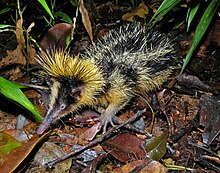Tenrecomorpha
| Tenrecomorpha | |
|---|---|

| |
| Lowland streaked tenrec (Hemicentetes semispinosus) | |
| Scientific classification | |
| Domain: | Eukaryota |
| Kingdom: | Animalia |
| Phylum: | Chordata |
| Class: | Mammalia |
| Order: | Afrosoricida |
| Suborder: | Tenrecomorpha Butler, 1972[1] |
| Superfamilies and Families | |

| |
Tenrecomorpha is the suborder of otter shrews and tenrecs, a group of afrotherian mammals indigenous to equatorial Africa and Madagascar, respectively.[2][3] The two families are thought to have split about 47–53 million years ago.[3][4][5] Potamogalid otter shrews were formerly considered a subfamily of Tenrecidae.[3] The suborder is also presumed to contain the extinct genus Plesiorycteropus, a group of possibly fossorial insectivores similar to aardvarks, which is known to be more closely related to tenrecs of subfamily Tenrecinae than to golden moles of suborder Chrysochloridea.[6]
Otter shrews are carnivorous and semiaquatic, preying on any aquatic animal they can find with their sensitive whiskers. All tenrecs are believed to descend from a common ancestor that lived 29–37 million years (Ma) ago[3][4][5] after rafting from Africa to Madagascar in a single event.[7][8] Tenrecs are widely diverse; as a result of convergent evolution they resemble hedgehogs, shrews, opossums or mice. All tenrecs appear to be at least somewhat omnivorous, with invertebrates forming the largest part of their diets.
References[edit]
- ^ Butler, P. M. (1972). "The problem of insectivore classification". In Joysey, K. A.; Kemp, T. S. (eds.). Studies in Vertebrate Evolution: Essays Presented to F. R. Parrington. Oliver and Boyd. pp. 253–265. ISBN 978-0-05-002131-6.
- ^ Bronner, G.N.; Jenkins, P.D. (2005). "Order Afrosoricida". In Wilson, D.E.; Reeder, D.M (eds.). Mammal Species of the World: A Taxonomic and Geographic Reference (3rd ed.). Johns Hopkins University Press. pp. 72–77. ISBN 978-0-8018-8221-0. OCLC 62265494.
- ^ a b c d Everson, K. M.; Soarimalala, V.; Goodman, S. M.; Olson, L. E. (2016). "Multiple Loci and Complete Taxonomic Sampling Resolve the Phylogeny and Biogeographic History of Tenrecs (Mammalia: Tenrecidae) and Reveal Higher Speciation Rates in Madagascar's Humid Forests". Systematic Biology. 65 (5): 890–909. doi:10.1093/sysbio/syw034. PMID 27103169.
- ^ a b Douady, C. J.; Catzeflis, F.; Kao, D. J.; Springer, M. S.; Stanhope, M. J. (2002). "Molecular Evidence for the Monophyly of Tenrecidae (Mammalia) and the Timing of the Colonization of Madagascar by Malagasy Tenrecs". Molecular Phylogenetics and Evolution. 22 (3): 357–363. doi:10.1006/mpev.2001.1055. PMID 11884160.
- ^ a b Poux, C.; Madsen, O.; Glos, J.; de Jong, W. W.; Vences, M. (2008). "Molecular phylogeny and divergence times of Malagasy tenrecs: Influence of data partitioning and taxon sampling on dating analyses". BMC Evolutionary Biology. 8 (1): 102. Bibcode:2008BMCEE...8..102P. doi:10.1186/1471-2148-8-102. PMC 2330147. PMID 18377639.
- ^ Buckley, M. (2013). "A Molecular Phylogeny of Plesiorycteropus Reassigns the Extinct Mammalian Order 'Bibymalagasia'". PLOS ONE. 8 (3): e59614. Bibcode:2013PLoSO...859614B. doi:10.1371/journal.pone.0059614. PMC 3608660. PMID 23555726.
- ^ Kinver, M. (2010-01-20). "Mammals 'floated to Madagascar'". BBC News web site. BBC. Retrieved 2010-01-20.
- ^ Ali, J. R.; Huber, M. (2010-01-20). "Mammalian biodiversity on Madagascar controlled by ocean currents". Nature. 463 (4 Feb. 2010). Nature Publishing Group: 653–656. Bibcode:2010Natur.463..653A. doi:10.1038/nature08706. PMID 20090678. S2CID 4333977.
